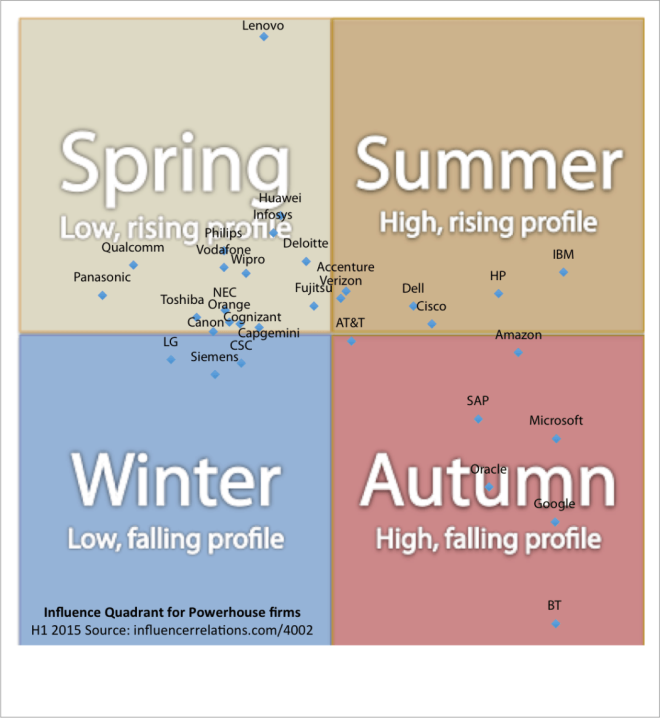Most of the eight large “Powerhouse” providers of ICT solutions are losing share of voice in analysts’ research. That’s the finding, which we previewed last week, of the H1 2015 Influence Quadrant for Powerhouse firms. It’s shown below, and you can click here to read about the Influence Quadrant method.

- BT: “friendly with solid professionalism”; “Great team. Very responsive”; “well engaged”.
- Google: “great relationship and they are very good”; “Excellent access to key execs”; “They are much more open, which is fantastic”.
- Oracle: “Excellent group of knowledgeable people”; “quite helpful in the research I do”; “Very talented group, knows coverage areas extremely well, very pro-active and engaged”.
Despite these comments from a minority of delighted analysts, most other analysts don’t feel the love from these firms in the same way. As a result, their profile is falling. Indeed analyst relations managers in every business are tempted to focus on the top analysts firms, like Gartner, IDC, and Forrester. However, many of these powerhouse firms are falling even in the research of those influential companies.
Not only is the volume of communication inconsistent between these companies, but so is their candor. Over time, the ability of enterprises to be candid with analysts is a reliable predictor of whether analysts will recommend these firms. Analysts tell us that Google and Oracle are among the least open firms. That lack of candor narrow the bottleneck even further and means that many analysts struggle to outline confidently the value those companies that deliver.
The good news is that this is easy to fix. Every firm has shows that it knows about to build strong relationships with its preferred analysts. However, these preferred analysts are not the only ones writing about Powerhouse companies and their competitors, even at the top analyst houses.
That said, while it is easy to fix, the will to change is pretty limited in these firms. Oracle’s approach to analysts certainly waxes and wanes, but it has been consistent for decades. It’s very unlikely that it will, for example, try to emulate Accenture. That opens up a competitive advantage. If you work at SAP or Atos, just to pick some names out of the air, it might not occur to you that your firm is exceptionally candid with analysts unless you see that in the Analyst Attitude Survey. That might be a bigger competitive advantage for you than, say, your vision and execution. If you play to that, then analysts will start to pick up that candor is a catalyst for vision and execution.
What does this mean for industry analysts? First, let’s say that the message is getting across. Firms that are using the Analyst Attitude Survey or similar tools generally improve year after year. Your feedback is evidence that AR teams are using successfully to get more resources and more commitment to half the analyst community. Similarly, you have no choice other than to write more about firms that are more open and write less about the ones that are secretive.
To find more about the Analyst Attitude Survey and the Influence Quadrant, contact us.
This post originally appeared on InfluencerRelations.com.
Ready for more? Subscribe to Kea Company’s Influencer Insights
Join thousands of peers and get Kea Company’s latest blogs, webinars and downloadable content straight to your inbox. Enter your email address below:
Error: Contact form not found.

